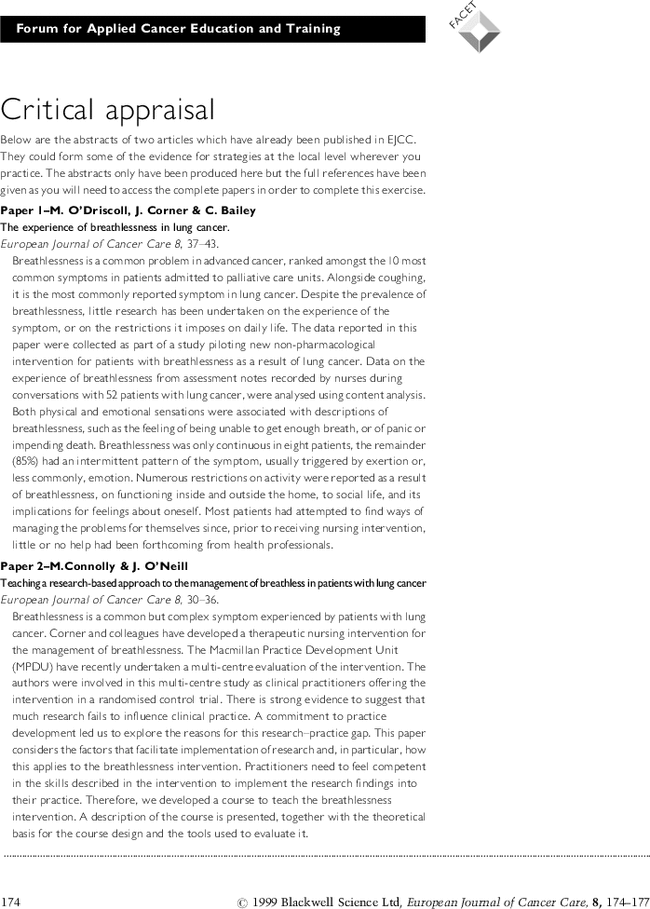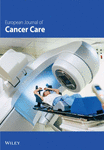Forum for Applied Cancer Education and Training
First published: 24 December 2001

References
- 1 Paper 1: References
- 2 Amhedzai S. (1993) Palliation of respiratory symptoms. In: Oxford Textbook of Palliative Medicine (eds Doyle D., Hanks G.W.C. & MacDonald N.) pp. 349 378. Oxford University Press, Oxford.
- 3 Bailey C. (1995) Nursing as therapy in the management of breathlessness in lung cancer. European Journal of Cancer Care 4, 184 190.
- 4 Boyd K.J. & Kelly M. (1997) Oral morphine as symptomatic treatment of dyspnoea in patients with advanced cancer. Palliative Medicine 11, 277 281.
- 5 Brown M.L., Carrieri V., Janson-Bjerklie S.J. et al. ( 1986) Lung cancer and dyspnoea: the patient’s perception. Oncology Nursing Forum 13, 519 524.
- 6 Cancer Research Campaign (1996) Lung Cancer and Smoking CRC Factsheet 11.1. Cancer Research Campaign, London.
- 7 Corner J., Plant H., Warner L. (1995) Developing a nursing approach to managing dyspnoea in lung cancer. International Journal of Palliative Nursing 1, 1 11.
- 8 Corner J, Plant H., A’Hern R. et al. ( 1996) Non-pharmacological intervention for breathlessness in lung cancer. Palliative Medicine 10, 299 305.
- 9 Corner J., Booth S., Wilcock A. et al. ( 1997) The palliation of breathlessness in patients with cancer: conclusions from a concensus workshop at the European Congress for Palliatve Care, London, September 1999.
- 10 Cowcher K. & Hanks G.W. (1990) Long-term management of respiratory symptoms in advanced cancer. Journal of Pain and Symptom Management 5, 320 330.
- 11 Davis C.L. (1994) The therapeutics of dyspnoea. Cancer Surveys: Palliative Medicine: Problem Areas in Pain and Symptom Management 21, 85 98.
- 12
Fishbein D.,
Kearon C.,
Killian K.J. (1989) An approach to dyspnoea in cancer patients.
Journal of Pain and Symptom Management
4, 205 217.
10.1016/0885-3924(89)90027-4 Google Scholar
- 13 Gift A. (1991) Psychologic and physiologic aspects of acute dyspnea in asthmatics. Nursing Research 40, 196 199.
- 14 Gift A.G., Plaut S.M., Jacox A. (1986) Psychologic and physiologic factors related to dyspnea in subjecs with chronic obstructive pulmonary disease. Heart and Lung 15, 595 601.
- 15
Heyse-Moore L.,
Ross V.,
Mullee M.A. (1991) How much of a problem is dyspnea in advanced cancer.
Palliative Medicine
5, 20 26.
10.1177/026921639100500105 Google Scholar
- 16
Krech R.,
Davis J.,
Walsh D.
et al. (
1992) Symptoms of lung cancer.
Palliative Medicine
6, 309 315.
10.1177/026921639200600406 Google Scholar
- 17 Krishnasamy M. & Plant H. (1998) Developing nursing research with people. International Journal of Nursing Practice 35, 79 84.
- 18 McCaffrey M. & Beebe A. (1989) Pain: Clinical Manual for Nursing Practice. Mosby, St. Louis, MO.
- 19 Muers M.F. & Round C.E. (1993) Palliation of symptoms in non-small lung cancer: a study by the Yorkshire regional Organisation Thoracic Group. Thorax 48, 339 343.
- 20 Reuben D. & Mor V. (1986) Dyspnea in terminally ill cancer patients. Chest 89, 234 236.
- 21 Roberts D.K., Thorne S.E., Pearson C. (1993) The experience of dyspnea in late-stage cancer: patients’ and nurses’ perspectives. Cancer Nursing 16, 310 320.
- 22 Skevington S.M., Pilaar M., Routh D. et al. ( 1997) On the language of breathlessness. Psychology and Health 12, 677 689.
- 23 Twycross R.G. & Lack S.A. (1986) Control of the Alimentary Symptoms in Far Advanced Cancer. Churchill Livingstone, Edinburgh.
- 24 Williams S.J. (1989) Chronic respiratory illness and disability: a critical review of the psychosocial literature. Social Science and Medicine 8, 791 803.
- 25 Williams S.J. (1993) Chronic Respiratory Illness: The Experience of Illness Series. Routledge, London and New York.
- 26 Paper 2: References
- 27 Bero L., Grilli R., Grimshaw J. et al. ( 1998) Closing the gap between research and practice: an overview of systematic reviews of intervention to promote implementation of research findings by health care professionals. In: Getting Research Findings into Practice (eds Haines A. & Donald A.S.) pp. 27 35. BMJ, London.
- 28 Carter D. (1996) Barriers to the implementation of research findings in practice. Nurse Researcher 4, 30 40.
- 29 Corner J. & Dunlop R. (1997) New approaches to care. In: New Themes in Palliative Care (eds Clark D., Hockley J. & Ahmedzai S.) pp. 288 302. Open University Press, Buckinghamshire.
- 30
Corner J.,
Plant H.,
Warner L. (1995) Developing a nursing approach to managing dyspnoea in lung cancer.
International Journal of Palliative Nursing
1, 5 11.
10.12968/ijpn.1995.1.1.5 Google Scholar
- 31 Davis D., Thomson M., Oxman A. et al. ( 1995) Changing physician performance: a systematic review of continuing medical education strategies. Journal of the American Medical Association 274, 700 705.
- 32 Haines A. & Donald A. (1998) Getting research findings into practice: making better use of research findings. British Medical Journal 317, 72 75.
- 33 Marteau T., Sowden A., Armstrong D. (1998) Implementing research findings into practice: beyond the information deficit model. In: Getting Research Findings into Practice (eds Haines A. & Donald A.) pp. 36 42. BMJ, London.
- 34 McKee L. (1998) Putting cancer research into practice. Nursing Times 94, 64 65.
- 35 Mulhall A. (1995) Nursing research: what difference does it make? Journal of Advanced Nursing 21, 576 583.
- 36 NHS Research and Development Programme (1995) Methods to Promote the Implementation of Research Findings in the NHS: Priorities for Evaluation. Report to the NHS Central Research and Development Committee. Department of Health, London.
- 37 Oxman A., Davies D., Haynes R. et al. ( 1995) No magic bullets: a systematic review of 102 trials of interventions to help health professionals deliver services more effectively or efficiently. Canadian Medical Association Journal 153, 1423 1443.
- 38 Schon D. (1983) The Reflective Practitioner. Arena, Aldershot.
- 39 Schon D. (1987) Educating the Reflexive Practitioner. Jossey-Bass, San Francisco.




